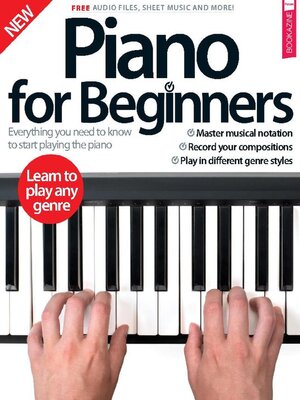Piano For Beginners
magazine ∣ 7th Edition · Piano For Beginners

Sign up to save your library
With an OverDrive account, you can save your favorite libraries for at-a-glance information about availability. Find out more about OverDrive accounts.
Find this title in Libby, the library reading app by OverDrive.



Search for a digital library with this title
Title found at these libraries:
| Library Name | Distance |
|---|---|
| Loading... |
Picking up any instrument for the first time can be daunting, but the new edition of Piano for Beginners will guide you through the learning process. From the correct way to sit at the piano to reading notation, we start with the basics before expanding your musical horizons with easy home recording and genre-specific tutorials. With a glossary of essential terminology, a list of chords and even access to free online resources, Piano for Beginners will be your go-to guide to mastering the piano or keyboard. Featuring: Getting started - Navigate the basics – from accessories to the pedals – with our ultimate guide. Understanding theory - Lay solid foundations by getting to grips with theory essentials. Playing the piano - Master your instrument with step-by-step tutorials. Play in the style of… - Get to know the hallmarks of your favourite genres and replicate their style.
Welcome to Piano for beginners
The ultimate guide to the piano • Unleash your musical talents and learn how to play scales, songs and masterpieces on the piano
How to sit correctly at the piano • Perfect posture is an essential task to master on the road to becoming a good piano player
Learn the white keys • Understand the natural keys on your piano or keyboard before you start
Learn the black keys • Get acquainted with the world of flats and sharps right here
Using the piano’s pedals • Advance your playing style by getting to grips with the pedals on the piano
What is musical notation? • Throughout this section we will begin to look at what musical notation is, how to read it and symbols that affect the way we play a piece
Introducing the staves • The five horizontal lines that enable us to read music
Notes and their values • Some of the different types of notes you’ll find on the staves
How to read musical notation • Learn which notes go where and use simple mnemonics to remember their positions on the staves
Understand time signatures • There are many different ways of changing the beats of the bar through time signatures, and each has its own distinct feel and style
Interpret key signatures • Explore the role of key signatures in music, learn why they are needed and how to read them
Learn about ledger lines • Get to grips with these essential parts of music notation with our simple step-by-step guide
Change note lengths • Learn how the duration of notes can be modified with dots and ties, and how they fit within multiple time signatures
Alter a note’s pitch with accidentals • Learn what these quirky symbols mean and whip your sharps and flats into shape
Navigate music notation • Time to get score savvy and stay on track through notation with repeats and endings
Control the volume with dynamics • Inject more personality into your music by learning to read and play using dynamics
Set and change the tempo • Ensure your jigs are jolly and your ballads are slow and beautiful by learning the essentials of musical tempo
Add articulations to notes • Play notes with character and style by familiarising yourself with articulations
Use musical ornaments • Learn about these extra pieces of musical goodness used to decorate a tune
Warm up your hands • Limbering up before you practise and play is an essential part of learning piano
Introducing musical scales • Understand how scales are formed and how important they are
The C major scale • This is a great first step for beginners because it forms the foundation for learning scales
The F major scale • Follow on from C major with this new scale, which contains a black key
The G major scale • The major scale that’s a fifth after C has just one sharp: F sharp
The D major...







